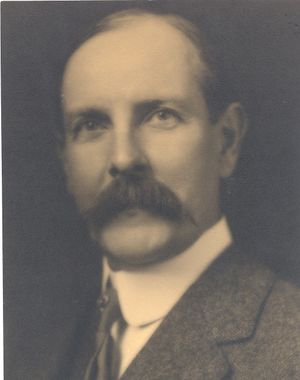Arthur E. Kennelly
- Birthdate
- 1861/12/17
- Birthplace
- Colaba, India
- Death date
- 1939/06/18
- Fields of study
- Radio, Physics
- Awards
- IEE Institution Premium, Franklin Institute Howard Potts Gold Medal, Cross of a Chevalier of the Legion d'Honneur of France, AIEE Edison Medal, IRE Medal of Honor
1898 -1900
1916
Arthur E. Kennelly, AIEE President, 1898 - 1900, IRE President, 1916, co-discovered the Heaviside-Kennelly layer in the ionosphere with Oliver Heaviside in 1901, which contributed to the study of radio waves.
Biography
Radio pioneer Arthur Edwin Kennelly, the son of an Irish naval officer, was born in Colaba, India (near Bombay), on 17 December 1861. Educated in England and France, he left school at the age of thirteen and taught himself physics while working as a telegrapher. In 1876, he left England and held various positions, including that of an assistant electrician in Malta, chief electrician of a cable repairing steamer, and, finally, senior ship’s electrician. In 1887, he immigrated to the United States and became principal assistant in Thomas Edison’s West Orange, New Jersey lab. Between 1894 and 1901, Kennelly worked as a consulting engineer for the Edison General Electric Company of New York. He then formed the consulting firm of Houston and Kennelly in Philadelphia with Edwin J. Houston. In 1902, the government of Mexico retained his firm to oversee the laying of the Veracruz-Frontera-Campeche cables. Kennelly also had a career in academia—he was a Professor of Electrical Engineering both at Harvard University and the Massachusetts Institute of Technology (MIT) and was a research associate at the Carnegie-Mellon Institute.
In 1901, Kennelly noticed that Guglielmo Marconi’s reception in Newfoundland of radio signals transmitted from England was received far better than predicted by radio-wave theory. Kennelly and the Englishman Oliver Heaviside, independently, and at approximately the same time in 1902, announced the probable existence of a layer of ionized gas high in the atmosphere that reflected radio waves. Formerly called the Heaviside or Kennelly-Heaviside layer (now called the E region), it is one of the several layers of the ionosphere. Although short wavelength radio waves penetrate the ionosphere, longer waves reflect off it instead, a property which allows them to “curve” around the earth and be propagate far beyond the horizon.
Kennelly is also known for the contributions he made to the analysis of alternating-current (AC) circuits with the publication of his paper “Impedance.” In that paper he described the first use of complex numbers as applied to Ohm's Law in AC circuit theory.
Kennelly received many awards during his lifetime. These included the IEE Institution Premium, the Franklin Institute Howard Potts Gold Medal, the Cross of a Chevalier of the Legion d'Honneur of France, and the AIEE Edison Medal (1933). In 1932 he received the IRE Medal of Honor "[f]or his studies of radio propagation phenomena and his contributions to the theory and measurement methods in the alternating current circuit field which now have extensive radio application." He served as president of the American Institute of Electrical Engineers fron 1898 to 1900 and president of the Institute of Radio Engineers in 1916. Kennelly died in Boston, Massachusetts on 18 June 1939.

